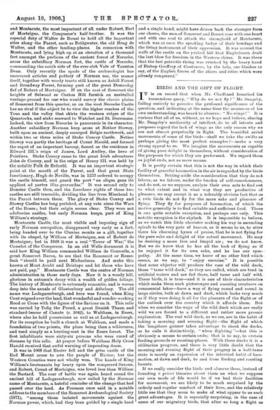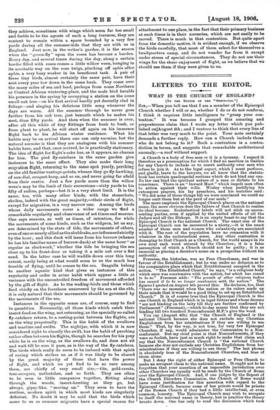BIRDS AND THE GIFT OP PLIGHT.
IT is on record that when Mr. Chadband launched hie tremendous query, " Why do we not fly P" Mr. Snagsby, failing entirely to perceive the profound significance of the question, and indicating at the same time the meanness of his own understanding, was heard to observe: " No wings !" It is curious that all of us, without, as we hope and believe, sharing Mr. Snagsby's mediocrity of intellect, do to all intents and purposes regard the lack of wings as the only reason why we are not almost perpetually in flight. The beautiful aerial movements of some of the birds—shall we take the swifts as perhaps giving the most perfect examples ?—make a very strong appeal to us. We imagine the movements as capable of giving pure delight in themselves, without consideration of the purposes for which they are performed. We regard them as joyful ends, not as mere means.
It is pretty certain that this is not the way in which their facility of graceful locomotion in the air is regarded by the birds themselves. Setting aside the consideration that they do not labour, as we labour, under the burden of self-consciousness, and do not, as we suppose, analyse their own acts to find out to what extent and in what way they are productive of pleasure, we may accept it as a tolerably obvious fact that as a rule birds do not fly for the mere sake and pleasure of • flying. They fly for purposes of locomotion, of which the motive generally is to find suitable and sufficient food. There is one quite notable exception, and perhaps one only. This notable exception is the skylark. It is impossible to believe, as we watch this little chorister making his way in ascending spirals to the very gate of heaven, as it seems to us, to utter there his charming hymn of praise, that he is not flying for the pure sake and delight of the actual movement. He may be desiring a more free and limpid air ; we do not know. But we do know that ho has all the look of flying as if he enjoyed it for its own sake, and he has oar sym- pathy. At the same time, we know of no other bird which seems, as we say, to " enjoy exercise." It is possible that some objector will produce the case of the wild duck, those " tame wild duck," as they are called, which are bred in artificial waters and are fed there, half tame and half wild. These birds, it is true—and it is one of their characterietioe which make them such picturesque and amusing creatures on ornamental lakes—have a way of flying round and round in large circles, both at dawn and dusk, which looks very much as if they were doing it all for the pleasure of the flight or of the outlook over the country which it affords them. But when we consider the ways of the wild duck which are really wild we are forced to a different and rather more prosaic explanation. The real wild duck, as we see, are in the habit of taking a morning and evening flight—the flight of which the 'longahore gunner takes advantage to shoot the ducks, as he calls it distinctively, " when fighting "—but this is obviously a means to certain ends; that is to say, to certain feeding-grounds or roosting-places, With these ducks it is a utilitarian progress, and there is very little doubt that the morning and evening flight of their progeny in a half-tame state is merely an expression of the inherited habit of loco- motion, at dawn and dusk, to and from feeding and roosting haunts.
If we really consider the birds and observe them, instead of founding a priori theories about them on what we suppose our own mode of life would be if we had their facilities for movement, we are likely to be much surprised by the orderly and regular conduct of their lives, and the relatively little use that they seem to make of what appear to us such great advantages. It is especially surprising, in the case of some of our migratory birds, that after so long a flight as they achieve, sometimes with wings which seem far too small and feeble to be the agents of such a long traverse, they are content to remain within a space bounded by a very few yards during all the summer-tide that they are with us in England. Just now, in the writer's garden, it is the season when the " green-fly " upon the roses has become a burden. Every day, and several times during the day, along a certain border filled with roses comes a little willow wren, hanging in its acrobatic way on the rose twigs, plucking off aphis after aphis, a very busy worker in its beneficent task. A pair of these tiny birds, almost certainly the same pair, have their nest every year low down in the same bush. They come over the many miles of sea and land, perhaps from some Northern or Central African wintering-place, and the male bird heralds his presence in the spring by occupying a station on the same small oak tree—on his first arrival hardly yet decently clad in foliage—and singing his delicious little song whenever the days are warm. All the summer through he never goes farther from his oak tree, just beneath which he makes his nest, than fifty yards. And then when the summer is over, after all this while of tiny fittings from bush to bush, or from plant to plant, he will start off again on his immense flight back to his African winter residence. What his habits may be on arrival there one can only surmise, but the natural surmise is that they are analogous with his summer habits here, and that, once arrived, he is practically stationary. The idea of flight for flight's sake has, as it appears, no charms for him. The pied fly-catchers in the same garden give instances to the same effect. They also make their long migration flight, returning to the same spot yearly, perching on the old familiar vantage-points, whence they go fly-hawking, of sun-dial, croquet-hoop, and so on, and never going far afield from their centre. Just a few yards more than the willow wren's may be the limit of their excursions—sixty yards to his fifty of radius, perhaps—but it is a very short limit. It is the same, too, with many other kinds, with the stonechats, shrikes, indeed with the great majority,—their circle of flight, except for migration, is a very narrow one. Among the birds whose daily movements cover a wider range we .find a remarkable regularity and observance of set times and seasons. One says seasons, as well as times, of intention, for while the movements of some kinds, such as the widgeon, let us say, are determined by the state of tide, the movements of others, even of one so nearly allied as the sheldrake, are influenced strictly by the hour; and this duck will issue from his burrow (whence he has his familiar name of burrow-duck) at the same hour " as regular as clockwork," whether the tide be bringing the sea close up to his front-door or taking it a mile out over a flat sand. In the latter case be will waddle down over this long extent, rarely being at what would seem to us the much less trouble of flying, until he comes to the sea. Seagulls belong to another aquatic kind that gives us instances of this regularity and order in avine habit which appear a little at variance with the uncontrolled freedom of movement afforded by the gift of flight. As to the wading-birds and those which feed chiefly on the foreshore uncovered by the sea at the ebb, it is only natural that their movements should be governed by the movements of the sea.
Instances in the opposite sense are, of course, easy to find in quantities. Necessarily, all those kinds which catch their insect-food on the wing, not returning, as the specially so-called fly-catchers return, to a resting-point between the flights, are on the wing perpetually. This is the habit of the swallows and martins and swifts. The nightjar, with which it is now considered right to classify the swift, has the habit of perching rather often between his flights, though he searches for his prey while he is on the wing, as the swallows do, and does not sit and wait till he sees it pass, as is the way of the fly-catchers. The birds which really do seem to be imbued with that spirit of roving which strikes us as if it was likely to be shared by the great majority of those that have the power of flight, and which we yet find to be so rare among them, are chiefly of very small size,—tits, gold-crests, tree-creepers, nuthatches, and so forth. They are often to be seen in little companies together, flitting along through the woods, insect-hunting as they go, but always, gipsy-like, "moving on." They seem to have the restless, modern spirit in which most kinds are singularly deficient. No doubt it may be said that the birds which come to us as summer migrants have a special reason for
attachment to one place, in the fact that their primary business at such times is in their nurseries, which are not easily to be moved. There is much in that contention. But quite apart from the domestic motive, it is evident enough, if we observe the birds carefully, that most of them select for themselves a headquarters camp, and do not wander far from it except under stress of special circumstances. They do not use their wings for the sheer enjoyment of flight, as we believe that wo should use them if they were given to us.



































 Previous page
Previous page